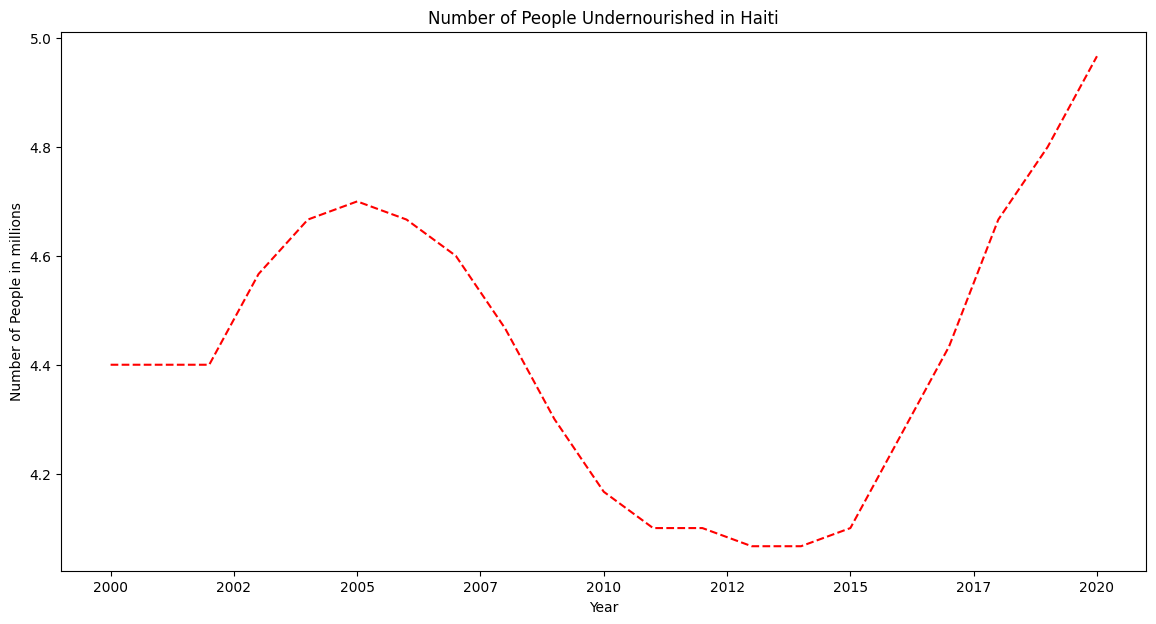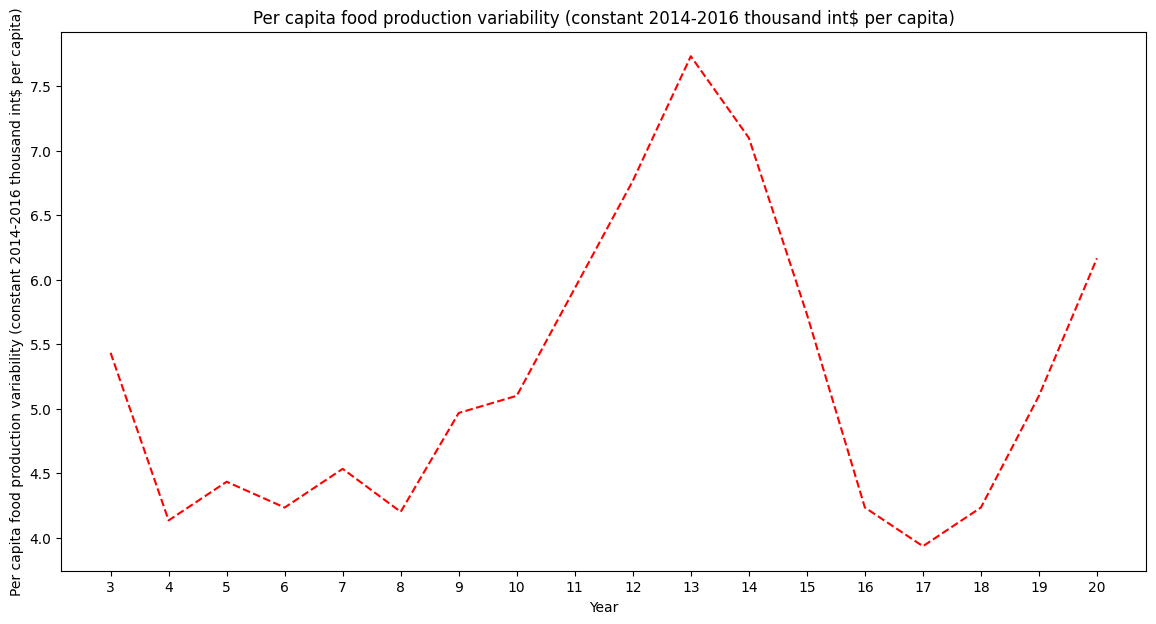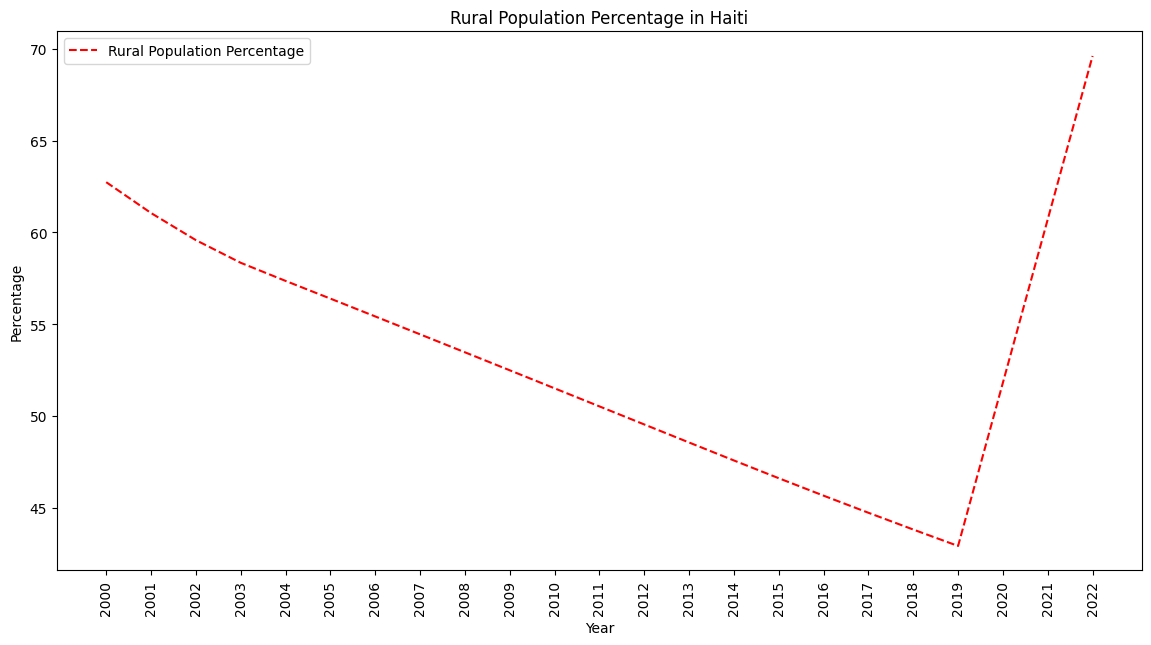Undernourishment
Haiti faces one of the highest levels of food insecurity globally, with 4.96 million people being undernourished in 2020. With a total population of 11.45 million, this means that over 43% of the population is experiencing a food crisis.
| Haiti - Undernourishment | |
|---|---|
| Year | Number of People (millions) |
| 2000 | 4.4 |
| 2001 | 4.4 |
| 2002 | 4.4 |
| 2003 | 4.566667 |
| 2004 | 4.666667 |
| 2005 | 4.7 |
| 2006 | 4.666667 |
| 2007 | 4.6 |
| 2008 | 4.466667 |
| 2009 | 4.3 |
| 2010 | 4.166667 |
| 2011 | 4.1 |
| 2012 | 4.1 |
| 2013 | 4.066667 |
| 2014 | 4.066667 |
| 2015 | 4.1 |
| 2016 | 4.266667 |
| 2017 | 4.433333 |
| 2018 | 4.666667 |
| 2019 | 4.8 |
| 2020 | 4.966667 |
Plot, illustrates rising number of undernourished people in Haiti (values in millions).

The most substantial spike in food insecurity began around 2016, coinciding with the largest deforestation event in the history of Haiti. While not a direct cause-and-effect relationship, it illustrates the interconnected socio-ecological trends and their impact on each other. As mentioned earlier, deforestation, especially on the scale observed in Haiti, leads to desertification, land erosion, and soil sterilization, directly and critically affecting food production.

This plot shows Food Production Variability per capita in the international dollar, also known as Geary–Khamis dollar (symbols G–K$ or GK$), is a hypothetical unit of currency that has the same purchasing power parity that the U.S. dollar had in the United States at a given point in time.
Despite agricultural land expansions, population movement to rural areas, and an overall increase in food production, Haiti remains one of the most food-insecure countries globally. Changes in the biosphere contribute to crop failures and inadequate yields. Furthermore, the population has doubled in the last 20 years, exacerbating the challenges faced by the nation.
1 “Over five million Haitians, including a record three million children, need humanitarian support in 2023. Nearly five million are acutely hungry, UNICEF said, adding the dire situation is “terrorizing children and families and destroying livelihoods amid unprecedented hunger, malnutrition and a resurgent cholera epidemic. Haiti was among the top five countries globally in terms of recorded cholera cases between 20 July and 31 August, and Artibonite has been worst area affected overall.” - source: “Haiti: Children facing triple threat of insecurity, malnutrition, disease.”
Distribution of Haiti population
Dataset used - Worldpop 2
Percentage of Haiti population leaving in rural areas (% of total population)
| Year | Rural Population (%) |
|---|---|
| 2000 | 62.738000 |
| 2001 | 61.056333 |
| 2002 | 59.580333 |
| 2003 | 58.346000 |
| 2004 | 57.359667 |
| 2005 | 56.394667 |
| 2006 | 55.423667 |
| 2007 | 54.449000 |
| 2008 | 53.470667 |
| 2009 | 52.490333 |
| 2010 | 51.507333 |
| 2011 | 50.523667 |
| 2012 | 49.539667 |
| 2013 | 48.556333 |
| 2014 | 47.577667 |
| 2015 | 46.610333 |
| 2016 | 45.660000 |
| 2017 | 44.728000 |
| 2018 | 43.814000 |
| 2019 | 42.918667 |
| 2020 | NaN |
| 2021 | NaN |
| 2022 | 69.613333 |
data for years 2020 and 2021 was unavailable. But the last year of data 2022, shows massive increase of people moving to the rural areas - 26.7% of entire population.
Change in rural population 2000 - 2022

Plot visualizing agricultiral expansion.

As explained in Deforestation section of the report, the time for decisive action is now. This action must be multilayered, addressing the identified problems in the following fields:
- Deforestation
- Food Insecurity
- Democracy
- Crime
- Policymaking
Addressing food insecurity requires a two-stage solution. The first stage involves immediate assistance through the transfer of food products since cash transfers may not be feasible given the extremely volatile situation in Haiti. However, the creation and distribution of food vouchers among the poorest could offer a viable alternative.
The second stage should focus on the development of rural areas and the establishment of a sustainable, modern, and ecological agrarian industry. Support in the form of tools, seeds, technical training, and education, particularly for the youngest population, is crucial. This educational effort aims to instill knowledge in sustainable farming practices and the use of technology to support these practices.”